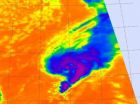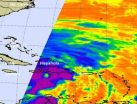(Press-News.org) WASHINGTON, DC—October 25, 2012—Biomedical and health research and development (R&D) spending from all sources declined by more than $4 billion or 3% between FY10 and FY11 according to Research!America's 2011 U.S. Investment in Health Research report. This represents the first drop in overall spending since Research!America began compiling the data in 2002.
The decline follows an uptick in research funding attributed to the American Recovery and Reinvestment Act (ARRA), which allocated $10.4 billion to the National Institutes of Health (NIH) over two fiscal years (2009-2010). The overall downward trend in R&D spending is coming at a time when other nations are ramping up their own investments in research, and meanwhile, pending across-the-board budget cuts (sequestration) could reduce federal biomedical and health research funding by 8%-10% or more.
"Insufficient funding, coupled with deep budget cuts under sequestration, could be devastating for research," said Research!America's chair, former Congressman John E. Porter. "Our global competitiveness hinges on a robust investment that will support bright scientific minds, create high-quality jobs and provide a catalyst for private sector innovation."
Research!America's 2011 U.S. Investment in Health Research report shows varying levels of health research funding in the private and public sector. For example, federal funding for research totaled $39.5 billion in FY11, a 14% decrease from the previous year's total of $45.9 billion. Agency funds were distributed across all 50 states to hospitals, universities, independent research institutes and small businesses. Under sequestration, the NIH would lose $2.53 billion in funding in FY13.
"As R&D spending abroad outpaces federal investments here at home, U.S. companies will set up shop in countries with stronger policies to support research," said Mary Woolley, president and CEO of Research!America. "We cannot afford to become complacent as cures for Alzheimer's, cancer, heart disease and other serious health threats remain a priority for every American."
Overall, private industry has continually increased investments in R&D — a total of $77.6 billion in 2011, a 1.4% increase from 2010, despite inflationary pressure and the economic recession. The pharmaceutical industry increased its investment to $38.5 billion, a 3% increase from the previous year. In contrast, biotechnology investment declined by nearly $800 million, or 3%. The medical device and technology sector slightly increased investment in research, totaling $9.8 billion. Currently, more than 80% of R&D among PhRMA member companies is conducted in the United States, but R&D spending abroad has more than doubled over the past decade.
Aside from federal and industry investment, other institutions spent $19.1 billion on health research, an increase of about 5% from the previous year. Universities increased spending of institutional funds for research to $11.9 billion in 2010, a 6% increase. Philanthropic spending decreased slightly, while voluntary health groups increased investment in research by 15%, or $131 million, from the prior year.
According to funding projections in the report, the research investment landscape could worsen in 2013 and over the next decade. The scenario is different in other countries; as just one example, China has identified biotechnology as one of the seven "strategic and emerging (SEI) pillar" industries and has pledged to invest $308.5 billion in biotechnology over the next 5 years. Overall, the report provides analysis that outlines health research as one of the underpinnings of the U.S. economy and a key to improving the health of Americans.
###Research!America has issued estimates of the US investment in health research since 2002. All reports in the series are available online at www.researchamerica.org/research_investment.
Research!America is the nation's largest nonprofit public education and advocacy alliance working to make research to improve health a higher national priority. Founded in 1989, Research!America is supported by member organizations that represent the voices of 125 million Americans. Visit www.researchamerica.org.
US investment in biomedical and health research on downward trend
Pending budget cuts will further jeopardize global leadership in research
2012-10-26
ELSE PRESS RELEASES FROM THIS DATE:
NASA sees warming cloud tops indicating Tropical Storm Tony weakening
2012-10-26
In a tropical cyclone, strong uplift of air pushes the tops of thunderstorms high into the troposphere. When that strength wanes, the cloud tops drop and become less cold. That's because the higher you go in the troposphere, the colder it gets. NASA satellite infrared data has revealed that Tropical Storm Tony's cloud top temperatures are warming and the storm is weakening.
The Atmospheric Infrared Sounder (AIRS) instrument aboard NASA's Aqua satellite captured infrared imagery of Tropical Storm Tony on Oct. 24 at 12:17 p.m. EDT that showed the strongest thunderstorms ...
NASA sees power in Hurricane Sandy moving toward Bahamas
2012-10-26
NASA's Aqua satellite passed over Hurricane Sandy as it was moving over eastern Cuba early on Oct. 25. The AIRS instrument captured an infrared image of Sandy that showed a large area of very high, cold cloud tops indicating the power within the storm. Sandy is now headed toward the Bahamas and warnings and watches have already been posted for the mainland U.S.
The Atmospheric Infrared Sounder (AIRS) instrument aboard NASA's Aqua satellite captured infrared imagery of Hurricane Sandy's eastern half on Oct. 25 at 0559 UTC (1:59 a.m. EDT) that showed some strong thunderstorms ...
NASA saw Tropical Storm Murjan making landfall on the Horn of Africa
2012-10-26
NASA's Aqua satellite watched from space as Somalia in the Horn of Africa experienced a landfalling tropical cyclone on Oct. 25.
On Oct. 25, NASA's Aqua satellite saw Tropical Storm Murjan begin to make landfall in eastern Somalia, just south of Cape Guardafui. Cape Guardafui is located in the northeastern Bari province and forms the geographical point of the Horn of Africa.
On Oct. 25, 2012 at 0720 UTC (3:20 a.m. EDT) the Moderate Resolution Imaging Spectroradiometer (MODIS) instrument that flies aboard NASA's Aqua satellite captured a visible image of Tropical Storm ...
USF researchers identify gene mutation linked to old age hearing loss
2012-10-26
TAMPA, Fla. (Oct. 25, 2012) - University of South Florida researchers have identified a genetic biomarker for age-related hearing loss, a major breakthrough in understanding and preventing a condition of aging that affects 30 million Americans and greatly diminishes their quality of life.
In a nine-year study that was a collaboration between USF's Global Center for Hearing & Speech Research and the National Technical Institute for the Deaf at the Rochester Institute of Technology, researchers were able to identify the first genetic biomarker for presbycusis. The genetic ...
NASA sees Tropical Storm Son-tinh moving into South China Sea
2012-10-26
Tropical Storm Son-tinh soaked the Philippines and is now moving into the South China Sea. NASA's Aqua satellite captured a visible image of the storm as the bulk western half of the storm had already moved over water.
On Oct. 25, 2012 at 0525 UTC (1:25 a.m. EDT) the Moderate Resolution Imaging Spectroradiometer (MODIS) instrument that flies aboard NASA's Aqua satellite captured a visible image of Tropical Storm Sin-Tingh. The image showed that the western half of the storm had already moved into the South China Sea, while powerful thunderstorms in the eastern half were ...
Study reveals impact of public DNS services; researchers develop tool to help
2012-10-26
A new study by Northwestern University researchers has revealed that public DNS services could actually slow down users' web-surfing experience. As a result, researchers have developed a solution to help avoid such an impact: a tool called namehelp that could speed web performance by 40 percent.
Through a large-scale study involving more than 10,000 hosts across nearly 100 countries, Fabián Bustamante, associate professor of electrical engineering and computer science at Northwestern's McCormick School of Engineering and Applied Science, and his team found that one cause ...
Triclosan needs to be monitored
2012-10-26
This press release is available in German.
Leipzig. Researchers from Germany and Slovakia have pointed out that the chemical triclosan is one of those particularly harmful substances for the ecological status of rivers that are still not sufficiently monitored. With extensive monitoring conducted in the Elbe river basin that was more comprehensive than standard monitoring procedures, concentrations of the chemical at numerous test sites exceeded the predicted no-effect concentration (PNEC) for algal communities up to a factor of twelve. From the 500 river basin-specific ...
Results of the AIDA STEMI MRI sub-study presented at TCT 2012
2012-10-26
MIAMI, FL – OCTOBER 25, 2012 – A study confirmed no differences in various measures of heart damage, according to cardiac magnetic resonance (MRI) imaging, in patients receiving the anti-clotting medication abxicimab directly into the heart (intracoronary) compared to those receiving it intravenously (IV). The results of the AIDA STEMI MRI sub-study were presented today the 24th annual Transcatheter Cardiovascular Therapeutics (TCT) scientific symposium. Sponsored by the Cardiovascular Research Foundation, TCT is the world's premier educational meeting specializing in interventional ...
Report: Bushmeat pushes Southern African species to the brink
2012-10-26
JOHANNESBURG, SOUTH AFRICA (October 25, 2012) – A recent report says illegal hunting of wildlife in South African Development Community (SADC) states can lead to the eradication of many species across extensive areas and even complete ecological collapse.
Africa's iconic large carnivores, such as cheetah, lion, leopard, and wild dog, are particularly vulnerable to this practice, either because they are caught in the bycatch from unselective methods such as snaring, or due to loss of prey. The report says that the scale and severity of the threat is such that, without ...
UC Davis researchers develop new drug delivery system for bladder cancer using nanoparticles
2012-10-26
(SACRAMENTO, Calif.) -- A team of UC Davis scientists has shown in experimental mouse models that a new drug delivery system allows for administration of three times the maximum tolerated dose of a standard drug therapy for advanced bladder cancer, leading to more effective cancer control without increasing toxicity.
The delivery system consists of specially designed nanoparticles that home in on tumor cells while carrying the anti-cancer drug paclitaxel. The same delivery system also was successfully used to carry a dye that lights up on imaging studies, making it potentially ...
LAST 30 PRESS RELEASES:
The perfect plastic? Plant-based, fully saltwater degradable, zero microplastics
Bias in data may be blocking AI’s potential to combat antibiotic resistance
Article-level metrics would provide more recognition to most researchers than journal-level metrics
Satiety’s little helper: Protein that supports appetite regulating protein identified
UF dives deep into predicting storm damage with computer models
A stormy ocean voyage yields insights on the global carbon cycle
Scientists identify first non-coding gene that controls cell size
Demonstration of altermagnetism in RuO₂ thin films -- A new magnetic material for the AI era
Penn researchers awarded $25M to conduct trial using smartphones to fight heart disease
PCORI awards funding for new patient-centered healthcare research
Exploring the origins of the universe: 145 low-noise amplifiers complete ALMA telescopes
Empress cicada wings help illuminate molecular structure
Using sound waves to detect helium
Time burden in patients with metastatic breast and ovarian cancer from clinic and home demands
Researchers discover bias in AI models that analyze pathology samples
Scientists ID potential way to prevent brain injuries from triggering Alzheimer's
MASTER 2nd Open Call: Execution period kick-off
Algae for health in food and pharma
Advanced microrobots driven by acoustic and magnetic fields for biomedical applications
Chicago health information leader recognized for raising CPR readiness and blood pressure awareness
The Intimate Animal, a new book from Kinsey Institute Executive Director Dr. Justin Garcia
When blue-collar workers lose union protection, they try self-employment
New video dataset to advance AI for health care
MEA-based graph deviation network for early autism syndrome signatures in human forebrain organoids
New modeling approach sheds light on rare gut disease
Study documents potentially hazardous flame retardants in firefighter gear
Can certain bacteria regulate aging of the immune system and its related alterations?
AI model helps diagnose often undetected heart disease from simple EKG
There are fewer online trolls than people think
Cell membrane fluctuations produce electricity
[Press-News.org] US investment in biomedical and health research on downward trendPending budget cuts will further jeopardize global leadership in research





